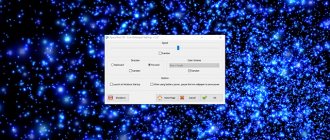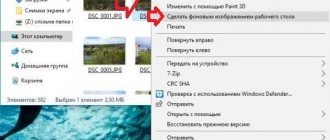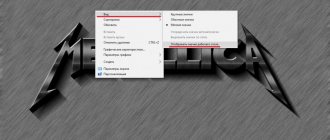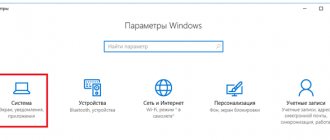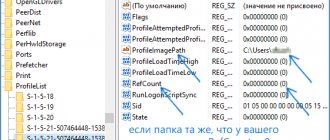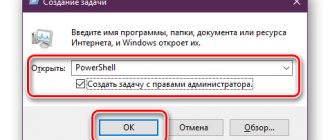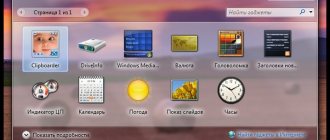The main reasons for a black screen
Identifying the cause will allow you to specifically eliminate the problem when the black screen turns on.
You just need to be attentive to the little things, for example, when you turn on the PC, is there any noise, whether the indicators on the case light up, etc. Even seemingly insignificant mechanical impacts on a complex device and the appearance of liquids on internal components as a result of temperature changes or careless user operation with the device are most often the causes of problems leading to a black screen. Also, among the main reasons why a black screen appears, special attention needs to be paid to the following:
- Hardware or software conflicts, as a result of which the graphical interface cannot be displayed;
- Battery malfunction;
- Problems with video accelerator, RAM, motherboard, hard drive, etc.;
- Driver incompatibility;
- Device overheating;
- System failure;
- Problems with the display (monitor).
Determining the nature of the error
A black screen when turned on can be caused by both software and hardware failures. The nature of the problem can be determined by answering the following questions:
- Do the LEDs on the computer case light up?
- Do coolers start when you try to turn on your PC?
- Does the BIOS logo flash before the dark screen appears?
- Are monitor brightness and contrast settings available?
Expert opinion
Daria Stupnikova
WEB programming and computer systems specialist. Editor of PHP/HTML/CSS site os-helper.ru .
Ask Daria
If you answer the above questions in the affirmative, then the problem is of a software nature and in most situations can be solved in several steps.
What to do if a black screen appears when loading Windows 10 or 7?
A black Windows screen indicates serious problems with the PC, so people who do not have sufficient experience are better off trusting a specialist.
I consider it my duty to note that all the recommendations below serve as informational material and not a call for mandatory implementation. Interfering with the operation of complex devices without experience can damage an expensive gadget.
It is better to perform simple actions, the meaning of which is completely clear to a person, and not try to gain experience at the cost of causing unconscious harm to the computer. For example, simply completely disconnecting the PC from power and then turning it back on in half the cases leads to the successful loading of Windows 7-10.
Only when this does not help should you proceed to more complex measures described later in this guide.
Laptop does not turn on, black screen, settings failure
This variant of the problem may be caused by a failure in the hardware settings. In this case, you will need to perform a reset.
In order to perform a hard reset, you need to follow the instructions below.
- Disconnect the laptop from power.
- Pull out the battery
- Press and hold the power button for about 15 seconds
- Give the RAM, wipe the RAM contacts with an eraser, let it sit for 5-10 minutes, insert it back.
- After that, insert the battery and connect the laptop to power.
After which the black screen should not appear when you turn on the laptop.
System rollback or boot from a Windows restore point
After installing a utility or game on your computer, a black screen often appears when loading Windows. In these cases, using the restore point (TV) function through safe mode (BR) will help.
The following steps must be taken:
- Start the PC from a bootable USB flash drive;
- Click “System Restore”;
- For the PC to enter BR after reboot, use the command: “bcdedit /set safeboot minimal”;
- Restart PC;
- Log in to the control panel (in “Ten” this menu was called “Options”);
- Open the “Update/Security” tab and go to the “Recovery” section;
- Click “Start”;
- Next, choose one of the two proposed options for action (at the personal discretion of the computer owner);
- Wait until the process completes.
- Ready.
How to fix black screen when booting Windows
Seeing a black screen on your monitor is always scary. Sometimes this is scarier than the blue screen of death, in which there are at least some signs of life. In our article we will look at the common causes of this problem and ways to fix a black screen on your computer.
The most obvious solution
Usually the cause of the appearance of the “Malevich square” is a poor connection of the cable running from the monitor to the system unit. And if this is a laptop, then the reason for the shutdown may be accidental pressing of the Fn and F2 . Their simultaneous use leads to turning the screen on and off. So before we move on to other reasons, double check that all the above-mentioned things are in order.
Windows output to the wrong monitor
If you have configured your PC to use multiple monitors and a second screen is not connected, this may cause a black screen to appear in Windows. How to solve this problem? Assuming you are on your operating system, double-click the Win key + P followed by Enter . Is there no reaction? Then click Win + P and then “Enter” . If this doesn’t work, repeat the operation four times and click “Enter” .
The combination of these keys changes the display mode. Each click cycles through the monitors and could potentially cause your main display to reappear.
Changed video output port
There are times when the default video port is changed without your permission. This usually happens after updating the Windows driver or video card driver. For example, when using a DVI cable, the port may change to HDMI. Or your video card's HDMI port will default to the one on your motherboard.
Try connecting the HDMI cable to different HDMI ports on your PC. Do this along with the above tip about Win + P.
Safe mode
Another option is to restart your PC in Safe Mode.
1. Press and hold the Power Button to shut down your PC, and then start it again. Once it starts loading, click F8 and wait for the recovery screen to appear.
2. Select one of the suggested download options and wait for the process to complete. If the image returns, most likely the problem lies in the video card drivers. Therefore, be sure to start updating them without delay. We will tell you how to implement this in our article below.
Driver problems
Driver problems are one of the most common causes of a black screen. Updating drivers is not at all difficult, and you need to do it periodically to constantly keep your PC in good health. Of course, for those who are familiar with a computer, you can download all the necessary drivers manually. But if you are afraid of doing something wrong, you can entrust this work to a third-party program.
There are a large number of such applications, for example, Driver Talent or Driver Easy .
Below I will tell you how to update drivers using Driver Easy .
1. First, go to Safe Mode as we described in the previous paragraph.
2. Download and install Driver Easy .
3. Activate Driver Easy and click Scan Now . The application will check your PC for driver problems.
4. Click "Update" next to your graphics card driver. Following this, the utility will download and install the current version of the driver.
If you want to use the Update All , which will automatically download and install the correct versions of all missing or outdated drivers on your system, you will need the paid version of Driver Easy.
Disabling Quick Launch
This is another good method to solve the black screen problem.
1. Restart your PC in Safe Mode.
2. Go to the Control Panel through Start and then to “Power Options”.
3. Find there “Action of the power buttons” and click on them.
4. Now click on “System Settings”.
5. Uncheck the box next to “Enable Fast Startup.”
Disable the built-in video card
If you have another one in addition to the built-in video card, then problems may also arise that lead to a black screen when loading Windows. Disabling the integrated graphics card may resolve the issue.
1. Restart your PC in Safe Mode.
2. Press Win + R.
3. Type devmgmt.msc and click OK.
4. In the "Display adapters" section you will see several video cards. Right-click on the integrated graphics card (usually Intel or AMD) and click Disable. If you are not sure which video card is the built-in one, you can disable them one by one and see if this solves the problem.
Advice for gamers
Sometimes a video card update (be it AMD, Nvidia or Intel) doesn't go as expected. In addition, errors occur in the operation of the current video card. All this leads to the fact that you have to fix the appearance of a black screen in Windows. This problem is solved by switching to safe mode and then reinstalling or updating the drivers.
To perform this operation we will need a Windows installation disk. Let's insert it into the PC and reboot. As soon as the computer starts booting again, click not on “Install” (this is very important), but on “Restore computer”. Next, click “Diagnostics” “Advanced options” “Command line”.
There we enter the value c: → press “Enter” and continue:
bcdedit /set bootmenupolicy legacy.
“Enter” again .
Now close everything and click on “Turn off computer”. Then turn it on again, and when it starts to load, press F8 . In the “Advanced Boot Options” menu that opens, go to “Safe Mode with Network Drivers.” And then you can directly start updating or reinstalling the drivers of your video card.
Using LifeCD (boot disk) and troubleshooting problems
LifeCD will help eliminate the appearance of a black screen when starting a PC. The sequence of steps is as follows:
- Install lifeCD into the drive;
- Next, while the PC is booting, enter the BIOS and set the priority of starting the OS from the drive;
- Close the BIOS, saving the adjustments entered into it;
- Wait for the PC to start from the disk;
- "System Restore";
- "Further";
- Click “Startup Recovery”;
- Wait;
- Ready.
Laptop freezes while loading Windows
In addition to faulty PC hardware, stopping, freezing, or rebooting without an error can also occur due to problems with the operating system.
Solving the problem of freezing while loading Windows
These problems may occur on the Windows splash screen or on a black screen, with or without a blinking cursor.
Reference! Before following the recommendations below, it is important to follow the steps in the “Make sure the laptop is completely turned off” at the beginning of the article.
Go to Safe Boot Mode
For Windows 7:
Step 1. When turning on the laptop, press and hold the “F8”, “F1” or “F12” key.
When turning on the laptop, press and hold the “F8” key
Step 2. When a special menu appears, select “Safe Mode” with the cursor arrows and press “Enter”.
Use the cursor arrows to select “Safe Mode” and press “Enter”
For Windows 8 and 10:
Step 1. Boot from a recovery disk or bootable USB flash drive.
Step 2. In the language selection window, press “Shift+F10”.
In the language selection window, press “Shift+F10”
Step 3. Type the sequence: “bcdedit /set {default} safeboot minimal” and press “Enter”.
Type the sequence “bcdedit /set {default} safeboot minimal”, press “Enter”
Remove conflicting drivers
Step 1. After Windows has booted securely, press the key combination “Win+R”.
Press the key combination “Win + R”
Step 2. Type “devmgmt.msc” in the menu and click “OK”.
Type “devmgmt.msc” into the menu and click “OK”
Step 3. Identify conflicting and uninstalled devices in the Device Manager, marked with a question mark or exclamation mark, by opening the device branches by clicking on the triangle icon.
Expand the device branches by clicking on the triangle icon to identify a conflicting or uninstalled device
Step 4. Delete the marked devices by right-clicking on them and selecting “Delete” with the left mouse button.
We delete the marked devices by right-clicking on them and selecting “Delete” with the left mouse button.
Step 5. When asked about deleting, click “Yes”.
Scan your PC for viruses
A virus or other malware may cause problems starting Windows. NOD32 antivirus is well suited for scanning in safe mode.
If problems arise with the system, scan it with the installed antivirus
Check your hard drive for errors
Step 1. Press “Win+R”, type “cmd” and click “OK”.
Type “cmd” and click “OK”
Step 2: Type “chkdsk /f /r” and press Enter. The system will check the disk for errors and correct them.
Type “chkdsk /f /r” and press “Enter”
Start from last known known good configuration
If Windows won't boot, loading the Last Known Good Configuration may help.
Step 1. Press “Win+R”, type “control panel” and click “OK”.
Type “control panel” and click “OK”
Step 2: Select Large Icons and click Recovery.
Select “Large icons” and click “Recovery”
Step 3. Select “Start recovery...”.
Select “Start recovery...”
Step 4 : Click Next.
Click “Next”
Step 5. Select a restore point and click Next.
Select a restore point and click “Next”
Step 6 : Click “Done.”
Click “Finish”
Windows recovery will start.
We are waiting for the recovery process to complete
Step 7: A message indicating the restoration has been completed will appear. Restart PC.
Click “Reboot”
Reference! When troubleshooting Windows problems, recommendations related to the laptop hardware are also suitable.
For example, you can replace the hard drive data cable, which affects the stability of loading the operating system, and the CMOS battery after 3 years of operation of the device.
Perform a clean installation of Windows
If, despite the steps taken, Windows still freezes, perform a clean installation from the installation disk or USB flash drive.
If all else fails, perform a clean installation from the installation disk or USB flash drive
Booting into Safe Mode and Troubleshooting Problems
If a black screen appears when you turn on the computer, it is recommended to use BR (safe mode). To start in BR and fix the problem, you only need to complete a few steps:
- Immediately after turning on the PC, press “F8” (another button may be used, so you must first read the accompanying documents for the PC);
- Using the arrows on the keyboard, select BR and click “Enter”;
- Wait for loading;
- "Start";
- “Programs” and go to the “Standard” section;
- Click “Service”;
- Click “System Restore”;
- Specify TV (recovery point) and click “Next”;
- Click “Done”;
- Wait for completion;
- All!
Possible reasons
Before we begin to figure out why, after turning on, instead of the usual Windows boot, you see a black screen and cursor, let’s look at the possible causes of this problem:
- Installing an unlicensed copy of the system.
- Damage to system files or registry.
- Viral infection.
- Problems with video card drivers.
- Hardware faults.
If the black screen does not appear immediately, but when Windows starts, try loading the Last Known Good Configuration. Windows 7 users need:
- Restart your computer (laptop).
- When starting, press F8 until the menu appears.
- Select Load Last Known Known Configuration.
Unfortunately, this convenient option is missing on Windows 8. Therefore, you will have to check the system through safe mode (if the last known good configuration on Windows 7 did not help, also use safe mode).
Disabling unnecessary or conflicting programs
After loading into BR, open the control panel and go to the “Programs and Features” tab, where you sort programs by the time they were installed on the PC. Often simply uninstalling the most recently installed utilities will fix the problem. Also, CCleaner, which is available for free on the Internet, allows you to uninstall applications without leaving “tails” behind them.
If the user does not want to uninstall utilities, they can be disabled and excluded from the Windows autorun list:
- In the search line (Windows key combination + R) of Start, type “msconfig”;
- After clicking on “Enter”, enter Services in the menu that appears, where you can disable unnecessary programs, and from the “Startup” tab, remove applications that are unnecessary for everyday use.
For Tens users, to get to the startup section, just launch the “Task Manager” (TZ).
Video driver update
Video drivers are available for free, but during installation you need to be careful so that the software is fully compatible not only with the components of the PC, but also with the operating system running on it. To find out the exact information about which drivers need to be installed, it is recommended to use the “dxdiag” parameter.
By clicking on the “Windows and R” key combination, you will need to type the above word and click “Ok”. A menu will be displayed where, in the “Screen” tab, you can view information about the video accelerator installed in the PC. After searching for drivers, downloading them and installing the latest versions of the software, the black screen no longer appears. However, it happens that it is also caused by malicious applications that have infected the system. The next paragraph of the instructions is devoted to this reason.
Restoring the Windows Registry and Explorer
Windows provides automatic creation and saving of copies of the registry in the “System32\config\RegBack” directory, which is located in the Windows partition.
You need to move the files from the specified directory to the “config” directory. Of course, in this case you will have to confirm the firmness of your intentions and click “Replace”. This is easy to do when the explorer is functioning normally, but if not, you will need to restore it using the OS boot disk and the AVZ utility.
To this end, perform the following actions:
- Open the main menu “AVZ” (you can use the “portable” version of this free antivirus program, which runs from a flash drive);
- Click “File”;
- Click “System Restore”;
- Check the boxes for “Explorer Restore” and “Desktop Restore”;
- Click “Perform selected operations”;
- Log in to the “Control Panel”;
- Next, go to the “Add and Remove Programs” tab;
- Uninstall suspicious utilities;
- Install bootable media with the OS into the drive and then in the “File” tab click “DZ”;
- Click “New task” and then type “sfc /scannow” in the command line;
- Click “Enter”;
- Restart the PC by logging into Windows in BR;
- Open the directory located on the OS CD under the name “i386”;
- Copy explorer.ex_, temporarily removing one letter from the extension;
- Copy the created file to the system volume;
- Next, add the missing letter “e” in the extension;
- After typing “regedit”, click “Ok”;
- Open the directory HKEY_LOCAL_MACHINE;
- Expand content “Software”;
- Go to the “Microsoft” folder;
- Open the “WindowsNT” subfolder;
- Next, from the “CurrentVersion” directory, go to the “Winlogon” subdirectory;
- For “Shell”, indicate the location of the file created when performing steps 15-17;
- Click “Ok”;
- Open the “DZ” menu again;
- Right-click on the “explorer.exe” process;
- Click “End process”;
- Then in the remote control “New task”;
- Type "cmd";
- Click “Ok”;
- In the console, type “Cd C:\”;
- Click “Enter”;
- Type “copy explorer.exe C:\Windows”;
- Input;
- "Yes";
- Restart PC;
- Ready.
How to remove the black screen after updating Windows 10?
If such a failure occurs after updating Windows 10, fixing the error does not take much time, since usually the mouse cursor and keyboard remain operational. The sequence of actions is as follows:
- CTRL + Shift + Esc;
- In the DZ, click “File”;
- Click “Run new task”;
- Type “cmd” and specify creation with extended privileges;
- Type “sfc /scannow”;
- "Input";
- Automatic analysis and error correction will begin.
Problems with contacts or monitor
Desktop and mobile PCs are equipped with a VGA socket. You can connect another monitor through this socket. If there is no such socket, then you will need to use the HDMI connector. The main thing is that the procedure for connecting an additional display is carried out with the PC turned off.
In case of normal operation with the additional monitor, you can make a diagnosis of a malfunction of the original one. An ordinary user cannot cope with repairing a monitor on their own, so it is recommended to contact a specialist.
Mechanical damage to the motherboard or video card
The most complex part of a PC is the motherboard (motherboard). There are dozens of components on it, any of which is a fragile and small element. It is not possible for a simple user to identify the cause of a motherboard malfunction, since this requires special diagnostic equipment.
Mechanical damage occurs when PC components, such as RAM strips, cards, and the processor itself, are installed incorrectly on the motherboard. Even a simple case of a needle or a piece of wire getting on the surface of the motherboard leads to the failure of expensive equipment. Upon careful examination, sometimes you can identify defects in contacts in slots, crumpling (swelling) of resistors, broken tracks (scratches), darkening of some areas on the motherboard, but without the skills and tools to repair the component, it is not recommended to carry out resuscitation actions on your own.
Sometimes even the burning smell coming from the computer case can tell you what the problem is.
Similar problems apply to video cards, which usually need to be replaced with new ones after mechanical damage.
HDD (hard drive) failure
Although the most terrible situation, when the motherboard fails, has already been considered, an equally unpleasant surprise is the failure of the hard drive. Moreover, there is not even a cursor arrow on the monitor. You should diagnose the hard drive and, perhaps, you will be able to save the important information stored on it. In case of negative diagnostic results, all that remains is to buy another HDD or hard drive for your PC. You can tell that it is the HDD that is broken (if the PC cannot boot) by the smell of burning, strange sounds from the HDD when it is operating, or the absence of minor vibrations or heating during its operation.
Why does a black screen appear when launching games or steam?
Gamers are the most likely to encounter glitches. Even purchasing official versions of games does not guarantee the absence of errors and black screens. Most often, the weak link is the video accelerator and problems with drivers, as already noted above in this guide.
Therefore, first of all, it is advisable to analyze the operation of the graphics adapter, for example, using the FurMark application. It will provide information about the video card model and its operating modes. The Game Booster program has similar functionality. Gamers are recommended to regularly analyze the operation of the video accelerator using these software.
Based on the results of the analysis, the user will know what measures need to be taken, for example, upgrading drivers. Also, failure to launch games occurs if there are problems with other PC components, which often overheat under increased load. It is necessary to clean them from accumulating dust and change thermal paste, otherwise heat is dissipated less efficiently. Gamers for popular games have developed standard algorithms for eliminating failures in the form of a black screen. They will be discussed further.
Black screen when booting computer
See also:
- Category “Restoring your computer”
- Computer won't turn on black screen
- Windows 8 black screen with cursor. What to do?
- Answers on questions
- The computer turns on but there is no picture
Today we will talk about how to remove the black screen when you boot your computer and what it actually is.
Let me describe all the reasons that can cause a black screen when booting a computer, and below I’ll tell you in more detail about them one by one, and also explain how to properly deal with a black screen.
- Driver problem. (most likely with video adapter drivers)
- The monitor or cable (VGA, HDMI, etc.) does not work. This also includes user errors. (The monitor is not plugged in, the cable from the video adapter does not go to the monitor. If you have 2 video drives, then maybe you inserted the cable into the wrong slot)
- The operating system has already outlived its usefulness. Reinstallation required. In this case, usually when the computer boots, the black screen will not be blank, but with some kind of error.
- PC needs to be cleaned from dust
- Serious hardware problems.
I would also like to divide all the black screens when loading into 2 categories, and I think you will agree with me.
- The problem is with the PC hardware.
- The problem is in the PC software.
Finding out which category your problem belongs to is very simple: If, when you boot your computer, a black screen appears immediately (that is, no characters appear on the monitor before Windows starts) - you have a hardware problem , and if the PC writes something (and even the system may start boot) and then goes out, then most likely you have a software problem. (that is, the problem is in the drivers or the system) The only exception is the hard drive.
When problems occur with the hard drive, the system does not boot (or takes a very long time to do so) and usually the computer displays an error, for example in the following format:
The Internet is full of instructions on how to check your hard drive. I recommend the program Victoria 4.47. She also knows how to repair damaged sectors. (unless of course they are damaged by software)
Also, if when you boot your computer there is a black screen with some kind of error written on it, go ahead and type this error into the search bar. You are not alone in this world with a similar problem. I guarantee you that what happened to you today happened to others much earlier. They described their problem and were helped to find a solution. Good luck in your search! =)
So, I really delayed the introduction... let's get down to business, namely, let's go through the list of reasons why a black screen appears when the computer boots.
1.Problem with drivers.
Most often, a black screen appears when loading a PC precisely because of this. And 90% of cases are due to the video adapter driver. Let's say you bought a new video card (or reinstalled the system, or decided to simply update the old driver) and after installation the system rebooted, but was unable to fully boot, and instead got a black screen. (sometimes with a cursor) There are many reasons why this happens: the PC simply does not support the new video card, crooked drivers, a very old system (does not fit new drivers and, as a result, needs to be reinstalled. ) too (so to speak) “sophisticated” drivers for old PC and so on.
Well, we seem to have sorted out the driver problem. Let's now move on to the solution. And the solution is very simple. You need to press the F8 key when you turn on the computer. The following menu will appear:
Here you need to select “Safe Mode” and after it loads, right-click on the “Computer” icon and select “Manage”. Next, go to “Device Manager”, select the video adapters tab there, click on it and remove the driver that you installed. To remove a driver, right-click on it and select remove. That's all. After this, the system should boot “as usual.” You also now need to install a different driver for your video card. For more information on how to do this correctly, see the “Installing Drivers” section. If the system still cannot boot normally, then again we go into safe mode. Click the “Start” menu, select “All Programs” then “Accessories” then “System Tools” and click “System Restore”. Read more about how to perform a system restore here.
2.Monitor or cable does not work
When booting the computer, the black screen may be due to the fact that the monitor is simply not plugged in or the power cables and picture transmission cables are slightly loose. Try tucking in all the cables. Also, a black screen during boot may appear due to the fact that the cable is inserted into the wrong video card . (There are computers that have a video card built into the motherboard and plus it has a connector for another video card (more powerful). In this case, the cable should be inserted into the video card that is inserted into the motherboard slot) Here is an example :
It happens that the picture transmission cable or, even worse, the monitor stops working. It's very easy to check. It is enough to connect the computer to the TV with the same cable. If everything on the TV shows without problems, the monitor is faulty, and if it doesn’t show, then either the cable or the computer is faulty. Read the article further and you will be able to diagnose and solve the problem yourself, because here I describe absolutely all the reasons why a black screen appears when you boot your computer.
3.Reinstall Windows.
Do you get a black screen when you turn on your PC? Everything is simple here. If the system before the “black screen” froze a lot , gave blue screens of death and generally lived its own life, and now when you boot the computer a black screen with errors appears, then it makes sense to check the hard drive, and if everything is fine with it, then reinstall the system.
4. The computer needs to be cleaned from dust
This is another reason why a black screen may appear when loading your PC.
Any computer sooner or later requires cleaning the computer from dust , replacing thermal paste and lubricating the fans. The fact is that dust is a very good conductor and can greatly interfere with the operation of the PC. Also, due to overheating, the computer may turn off. In my practice, most often it was necessary to clean the computer from dust. (you need to pull out all the components from their slots and blow them out.) The very first thing in case of heavy dustiness is the RAM , and the first thing I always did was pull out the RAM dies, blow out their slots, clean the dies themselves and insert them back. After that, the computer turned on as usual, but I still cleaned it completely (since I got around to it.)
5. Serious hardware problems.
If you have tried all of the above and still get a black screen when you boot your computer, then most likely you are faced with a serious problem. Most often the video card burns out.
The precursor to this is various streaks on the screen and artifacts.
The video card burns out due to the fact that the computer has not been cleaned for a long time and most likely the video card fan is clogged and can no longer cool it properly.
If you have 2 video cards (built into the motherboard and another that is inserted into the slot), then you have the opportunity to check the video card’s functionality. To do this, remove the video card from its slot and connect the “picture” transmission cable to the video card that is built into the motherboard. Turn on your computer. If everything works, go to the store for a new video card. If you have one video card, go to a friend and remove the video card from his computer. Insert it into the slot, connect the cable to it and turn on the computer. If the computer comes to life, go to the store for a new video card.
I will not describe more complex hardware problems (replacing the processor, motherboard), since this is too complicated for the average user, and advanced users solve such problems on their own.
If after reading this article and using ALL the methods described here, the problem is not solved, I recommend contacting a service center to diagnose and fix the problem. Wish you luck!
Black screen YouTube: How to remove the black screen on Android when watching a video from YouTube (but there is sound)
You can get rid of the black screen on your Android phone when playing a video by installing updates for YouTube.
If this does not help, then you need to do the following:
- Clean up the CoolPlay services using one of the “cleaner” utilities;
- Disable mobile data reception and transmission on the device and deactivate the Wi-Fi module;
- Enter settings;
- Go to Applications - all;
- Delete GooglePlay data;
- For the YouTube application, also clear all data;
- Next, delete the cache in the Memory tab;
- Close all running menus and reboot the gadget;
- Connect to the Internet;
- Ready.
What if when you turn on the laptop there is a black screen and cursor?
If there is an arrow on the screen, then you can fix the problem using software methods.
Adjusting the software settings:
- Disconnect the laptop from the network and remove the battery;
- Hold down the power button for about 10 seconds;
- Connect to the power supply (remembering to install the battery back; it is recommended to first wipe the contacts with alcohol);
- Turn on the laptop;
- Click start in normal mode;
- All!
Programs designed to remove the Windows black screen
In addition to the programs mentioned above, the “RemoveWAT21” utility effectively allows you to fix failures in Windows 7 computers due to activation problems. Steps:
- Install the utility;
- Remove activation;
- Reactivate and disable system license analysis;
- Ready. Now a black screen due to failed activation will never appear.
The described utility is equipped with a manual, so even beginners will not have any difficulties after installing it. Also, one of the most multifunctional programs is AVZ, the use of which has already been introduced above. An antivirus program can eliminate most of the causes of the error in question.
It can quickly restore the OS's response to exe, scr, pif and com files, and also help reset Internet Explorer protocol prefixes. If necessary, restores the Windows desktop and Explorer.
Reasons for the black screen
When solving the problem, you should first find the reason for the lack of image when you turn on the computer. The most common technical problems that you can solve yourself include:
- monitor malfunction;
- power is not supplied to the screen due to its disconnection or a breakdown in the power supply system;
- cable break or poor connection between the monitor and the system unit;
- connecting the screen cable to the wrong socket;
- For laptops, the problem associated with broken cables is a pressing one;
- the video card has burned out or moved away from the connector;
- The computer's operation has been transferred to an external monitor, but this problem most often applies to laptops.
All of the above failures are technical, but there are also problems associated with software that has failed or was installed incorrectly. There are cases such as:
- the operating system does not work correctly or is missing;
- drivers were installed or updated with errors;
- attack by a virus program that disrupts the operation of the operating system or driver;
- Setting a resolution that is incompatible with the monitor.
In this video you will learn what to do if when you turn on your computer you only see a black screen and a cursor.

